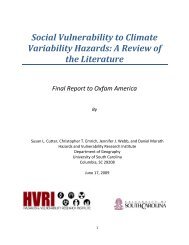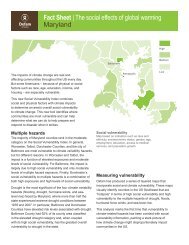Poverty Footprint Study on how the Coca Cola - Oxfam America
Poverty Footprint Study on how the Coca Cola - Oxfam America
Poverty Footprint Study on how the Coca Cola - Oxfam America
You also want an ePaper? Increase the reach of your titles
YUMPU automatically turns print PDFs into web optimized ePapers that Google loves.
Endnotes<br />
1. World Bank 2008 estimate of <strong>the</strong> number of people living <strong>on</strong> less than $1.25 a day, http://go.worldbank.org/T0TEVOV4E0.<br />
2. World Bank, http://web.worldbank.org/WBSITE/EXTERNAL/NEWS/0,,c<strong>on</strong>tentMDK:20040961~m e<br />
nuPK:34480~pagePK:64257043~piPK:437376~<strong>the</strong>SitePK:4607,00.html<br />
3. Extra push needed <strong>on</strong> aid, trade and debt to meet global antipoverty goals, UN Reports, http://www. un.org/<br />
millenniumgoals/pdf/MDG_PR_EN.pdf?NewsID=35832&Cr=UNICEF&Cr1=.<br />
4. Telling Our Story: Base of <strong>the</strong> Pyramid Investments, Inclusive Business 2010, Internati<strong>on</strong>al Finance Corporati<strong>on</strong>, World Bank Group.<br />
5. El Salvador has <strong>the</strong> sec<strong>on</strong>d-greatest ec<strong>on</strong>omic risk exposure in <strong>the</strong> world to multiple hazards. See World Bank, Natural Disaster<br />
Hotspots, A Global Risk Analysis (Washingt<strong>on</strong>, DC: Disaster Risk Management Series, 2005)Table 7.2<br />
6. http://www.who.int/whosis/mort/profiles/mort_afro_zam_zambia.pdf<br />
7. http://www.dfid.gov.uk/Documents/publicati<strong>on</strong>s1/strategic-visi<strong>on</strong>-girls-women.pdf<br />
8. Results of surveys made to Nejapa and San Salvador stores (June 2009).<br />
9. Growth in <strong>the</strong> ec<strong>on</strong>omic downturn, UK Government Department for Internati<strong>on</strong>al Development (DFID), www.dfid.gov.uk.<br />
10. DFID Press release (March 31, 2008), www.dfid.gov.uk<br />
11. Working paper series: Ec<strong>on</strong>omic growth, DFID research strategy (2008–13), www.dfid.gov.uk<br />
12. Unleashing Entrepreneurship: Making Business Work for <strong>the</strong> Poor, Commissi<strong>on</strong> <strong>on</strong> <strong>the</strong> Private Sector and<br />
Development, Report to <strong>the</strong> Secretary-General of <strong>the</strong> United Nati<strong>on</strong>s (March 1, 2004), p. 7.<br />
13. Andy Wales, Mat<strong>the</strong>w Gorman and Dunstan Hope, Big Business Big Resp<strong>on</strong>sibilities—From Villains<br />
to Visi<strong>on</strong>aries: How companies are tackling <strong>the</strong> world’s greatest challenges.<br />
14. Business and development: Challenges and opportunities in a rapidly changing world, The World Business Council for Sustainable Development.<br />
15. Business and development: Challenges and opportunities in a rapidly changing world, The World Business Council for Sustainable Development.<br />
16. Business and development: Challenges and opportunities in a rapidly changing world, The World Business Council for Sustainable Development.<br />
17. Stuart I. Hart and Mark B. Milstein, Creating Sustainable Value, Academy of Management Executive, Vol. 17, No. 2 (2003).<br />
18. Andy Wales, Mat<strong>the</strong>w Gorman and Dunstan Hope, Big Business Big Resp<strong>on</strong>sibilities—From Villains<br />
to Visi<strong>on</strong>aries: How companies are tackling <strong>the</strong> world’s greatest challenges.<br />
19. Unleashing entrepreneurship: Making Business Work for <strong>the</strong> Poor, Commissi<strong>on</strong> <strong>on</strong> <strong>the</strong> Private Sector and<br />
Development, Report to <strong>the</strong> Secretary-General of <strong>the</strong> United Nati<strong>on</strong>s (March 1, 2004), p. 9.<br />
20. Telling Our Story: Base of <strong>the</strong> Pyramid Investments, Inclusive Business 2010, Internati<strong>on</strong>al Finance Corporati<strong>on</strong>, World Bank Group.<br />
21. Unleashing entrepreneurship: Making Business Work for <strong>the</strong> Poor. Commissi<strong>on</strong> <strong>on</strong> <strong>the</strong> Private Sector and<br />
Development, Report to <strong>the</strong> Secretary-General of <strong>the</strong> United Nati<strong>on</strong>s (March 1, 2004).<br />
22. The <strong>Coca</strong>-<strong>Cola</strong> Company’s profit informati<strong>on</strong> was not shared with <strong>the</strong> research team. O<strong>the</strong>r suppliers chose not to share profit informati<strong>on</strong><br />
with <strong>the</strong> research team due to its sensitive nature. SABMiller shared detailed financial informati<strong>on</strong> including profit data.<br />
23. United Nati<strong>on</strong>s Development Program (UNDP) Human Development Report (2009), http://hdr.undp.org/en/statistics.<br />
24. Zambia averaged growth of 1 percent from 1990 to 1999, compared to 2.4 percent across <strong>the</strong> SADC regi<strong>on</strong>. See<br />
WTO doc WT/TPR/S/106 at www.wto.org/english/tratop_e/tpr_e/s106-1_e.document.<br />
25. K. Bruliard, “Zambia’s Copperbelt reels from global crisis,” Washingt<strong>on</strong> Post (March 25, 2009).<br />
26. K. Bruliard, “Zambia’s Copperbelt reels from global crisis,” Washingt<strong>on</strong> Post (March 25, 2009).<br />
27. Zambia Central Statistics Office (2009), http://www.zamstats.gov.zm/lcm.php.<br />
28. UNDP Human Development Report 2010<br />
29. Maternal mortality ratio reported, 2003–2008, p. 590, http://www.unicef.org/infobycountry/zambia_statistics.html.<br />
30. Ninety-two per 1,000 live births in 2008. See http://www.unicef.org/infobycountry/zambia_statistics.html.<br />
31. Figure based <strong>on</strong> 2006 data reflecting <strong>the</strong> percentage of pers<strong>on</strong>s aged 15 to 49 in <strong>the</strong> populati<strong>on</strong> who are HIV infected.<br />
32. UNDP Human Development Report 2010<br />
33. “El Salvador: Political, Ec<strong>on</strong>omic, and Social C<strong>on</strong>diti<strong>on</strong>s and U.S. Relati<strong>on</strong>s,” C<strong>on</strong>gressi<strong>on</strong>al Research Service (June 2009), http://www.fas.org/sgp/crs/row/RS21655.pdf.<br />
34. “El Salvador: Political, Ec<strong>on</strong>omic, and Social C<strong>on</strong>diti<strong>on</strong>s and U.S. Relati<strong>on</strong>s,” C<strong>on</strong>gressi<strong>on</strong>al Research Service (June 2009), http://www.fas.org/sgp/crs/row/RS21655.pdf.<br />
35. Encuesta de Hogares de Propositos Multiples (EHPM), Multipurpose Household Survey, General Statistics and Census Directorate of El Salvador (2007).<br />
36. El Salvador fact sheet available at http://hdrstats.undp.org/en/countries/country_fact_sheets/cty_fs_SLV.html and Zambia fact<br />
sheet available at http://hdrstats.undp.org/en/countries/country_fact_sheets/cty_fs_ZMB.html. See also World Bank, World<br />
Development Indicators, http://data.worldbank.org/data-catalog/world-development-indicators?cid=GPD_WDI.<br />
37. UNDP Human Development Report (2009).<br />
38. Statistics from CIA World Factbook.<br />
39. From in-country data and see www.vistual.vendor.coca-cola.com.<br />
40. Gross Value Added (GVA) is a measure of <strong>the</strong> value of <strong>the</strong> goods and services produced in <strong>the</strong> ec<strong>on</strong>omy. It is primarily used to m<strong>on</strong>itor<br />
<strong>the</strong> performance of a nati<strong>on</strong>al ec<strong>on</strong>omy and is a preferred indicator to measure <strong>the</strong> overall ec<strong>on</strong>omic well-being of an area. Both GVA and<br />
Gross Domestic Product (GDP) are measures of output. They both measure <strong>the</strong> value of <strong>the</strong> goods and services produced in <strong>the</strong> ec<strong>on</strong>omy.<br />
However, GVA differs from GDP in that GVA excludes taxes and subsidies. GDP equals GVA plus taxes, minus subsidies.<br />
41. It has been assumed <strong>the</strong> average wage is <strong>the</strong> same in ILC producti<strong>on</strong>, distributi<strong>on</strong> and sales. It has not been possible to adjust using separate wages<br />
bills for each part of <strong>the</strong> value chain or an average rate of pers<strong>on</strong>al income tax so that we can c<strong>on</strong>vert this to after-tax take-home pay.<br />
42. The indirect GVA multipliers of 1.25, 1.37 and 1.31 for <strong>the</strong> producti<strong>on</strong>, distributi<strong>on</strong> and sales sectors, respectively, were calculated using a Social Accounting Matrix<br />
obtained from <strong>the</strong> Internati<strong>on</strong>al Food Policy Research Institute and using a specialist software called IRIOS to extract indirect sector GVA multipliers. The indirect GVA<br />
multiplier expresses <strong>the</strong> ratio of combined direct and indirect GVA changes to <strong>the</strong> direct GVA change due to a unit increase in final demand. The indirect employment<br />
multipliers of 1.24, 1.25 and 1.09 for <strong>the</strong> producti<strong>on</strong>, distributi<strong>on</strong> and sales sectors, respectively, represent <strong>the</strong> ratio of direct and indirect employment to <strong>the</strong> number of<br />
direct jobs in <strong>the</strong> <strong>Coca</strong>-<strong>Cola</strong>/SABMiller system’s primary activities. Using employment data for each sector from <strong>the</strong> 2005 Census and GVA data from <strong>the</strong> 2005 Input-<br />
Output (IO) Table, researchers estimated <strong>the</strong> producti<strong>on</strong>, distributi<strong>on</strong> and sales sectors’ indirect impacts <strong>on</strong> employment across <strong>the</strong> ec<strong>on</strong>omy. This was achieved by<br />
first estimating <strong>the</strong> indirect GVA impact and <strong>the</strong>n applying to it <strong>the</strong> calculated ratio of employment to GVA. The difference between indirect and direct employment is <strong>the</strong><br />
indirect employment impact. The induced impacts were calculated by establishing <strong>the</strong> effect <strong>on</strong> GVA, wages and salaries, and employment of <strong>the</strong> direct and indirect<br />
wages and salaries generated by <strong>the</strong> producti<strong>on</strong>, distributi<strong>on</strong> and sales sectors. The IO analysis provided <strong>the</strong> marginal income effect, which would be <strong>the</strong> increase<br />
in GVA that would arise from an additi<strong>on</strong>al $1 of wages and salaries. This was <strong>the</strong>n applied to <strong>the</strong> combined direct and indirect GVA impact, providing an estimate<br />
of induced GVA impact. Finally, using this estimate of induced GVA, <strong>the</strong> researchers calculated <strong>the</strong> induced impact <strong>on</strong> employment using <strong>the</strong> previously calculated<br />
employment-GVA ratio. For <strong>the</strong> purpose of this analysis, <strong>the</strong> researchers used gross wages. This slightly overstates <strong>the</strong> induced impacts as take-home pay would have<br />
been a more accurate input into <strong>the</strong> analysis of <strong>the</strong> relati<strong>on</strong>ship between wages and GVA. The induced multipliers are usually referred to as Type II, and <strong>the</strong>y cover <strong>the</strong><br />
combined indirect and induced impact. In <strong>the</strong> interest of transparency of calculati<strong>on</strong>, s<strong>how</strong>n below are <strong>the</strong> induced-<strong>on</strong>ly multipliers. The induced-<strong>on</strong>ly multipliers for<br />
GVA are estimated to be 0.85 for <strong>the</strong> producti<strong>on</strong> sector, 1.69 for <strong>the</strong> distributi<strong>on</strong> sector and 7.78 for <strong>the</strong> sales sector. The induced-<strong>on</strong>ly multipliers for employment are<br />
0.81 for producti<strong>on</strong>, 1.14 for distributi<strong>on</strong> and 2.29 for sales. Overall, <strong>the</strong> combined multiplier for indirect and induced impacts in El Salvador was estimated to be 2.52.




